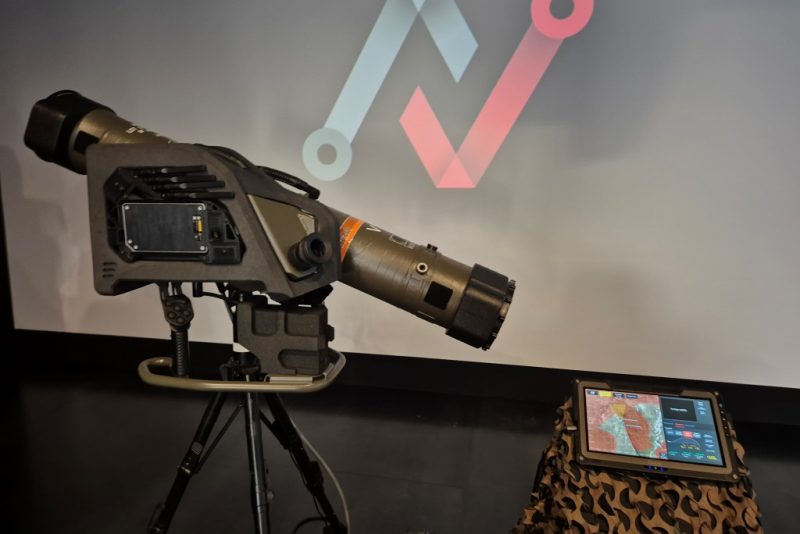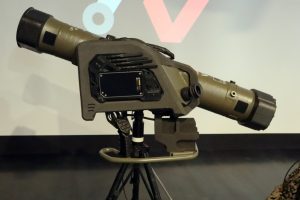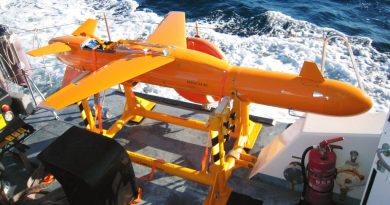Eurosatory 2024 – MBDA Akeron family grows: Ground Warden BLOS for the MP missile and soon new loitering munitions
At Eurosatory 2024 MBDA unveiled its Ground Warden, a plug and play system that allows the Akeron MP to easily engage beyond line-of-sight targets
“The evolution of today battlefield requirest two things, the first is to be agile and to adapt existing products, and this is what we are doing with the Akeron family, the second aspect being to be able to deliver in mass new capabilities of the battlefield,” Matthieu Krouri, Head of the Battlefield Sector at MBDA explains.
Starting from the latter, MBDA is involved in two programmes launched by the French Defence Innovation Agency, respectively known as Colibrì and Larinae; these aim at developing two “remotely controlled ammunition” or RCA, the French wording to indicate what is usually known as Loitering Munition or LM in short. Contracts for the two programmes were assigned to MBDA and to another competitor, MBDA having decided not to communicate on these effectors until selection will not be made by the French DGA. At Eurosatory it was however possible to know at least the status of the two developments; “Colibri is now finished and all what was necessary to finalize the contract was delivered on time. The customer is extremely satisfied of the system, because it delivers a level of performance which is better than expected, so we are in a good position for that competition. As for the other programme, the Larinae, this one is still under development. It is an RCA with a range of 50 kilometres, and we plan to perform some flights before year end, followed by a demonstration of cooperation engagement between UAV and the remotely controlled ammunition in early 2025. This will bring us in this new environment of low cost, beyond line of sight, effectors,” Matthieu Krouri concludes.
Switching to the Akeron family, the medium range missile is in service in France and Egypt, Ukraine having also received an unknown quantity of those missiles. Next in line are Belgium and Luxembourg, both set to receive their systems next year. In April 2023 France and Sweden signed a cooperation agreement that, among other, will see the Akeron MP replacing the Bofors Bill in Swedish Army service. In late 2023 the French Navy asked for a demonstration of the Akeron MP being fired from a ship; some adaptations were done to make it compatible with the constraints of a naval moving platform, qualification fires being concluded EDR On-Line understood, deliveries of the Akeron MP Sea Launched approaching, first systems being issued to Special Forces. In March this year the French Army took part in Capstone 4 of the US Project Convergence event and demonstrated the Akeron MP beyond line-of-sight capability, which was inherent since the system development as the missile could be fired on target designation with accurate flight path thanks to its Inertial Measurement Unit, with a lock-on-after-launch mode using the high trajectory mode [1].
To further improve the system flexibility and effectiveness MBDA developed the artificial intelligence-based Ground Warden, a system capable to fuse all deployed intelligence surveillance and reconnaissance (ISR) assets, and to co-ordinate Akeron family effectors to optimize the use of resources.
“In high intensity conflicts the warfighter is under pressure and needs to be more active, to react quickly to very complex situations,” Laurent Duport, in charge of the Ground Warden programme, states. This is true, especially for beyond line of sight engagements, where the operator does not directly see the target. To help the soldier in this type of engagement, MBDA developed a system where artificial intelligence acts on the battlefield in real time, processing data and giving immediate information, providing therefore a decision aid tool for the planning and decision process as well as the engagement itself. The work is done by a specific group of people, the Ground Warden Team, that is focused on agility to be able to respond very quickly to requests coming from the battlefield, where things evolve daily. The Ground Warden is therefore designed as an inherently evolving tool, the one demonstrated at Eurosatory being the 1.0 version. What the following versions will look like, will be very much the matter of what the soldiers on the field will require. When saying 1.0 this is pure reality, as the team demonstrating the system at the exhibition had just put his hands on it, and MBDA is looking at trials in the coming weeks to get first real feedback and define the product evolution, the system presented being readily available.
The Ground Warden is made of a case containing all the electronics, with all processing capabilities, AI algorithms and communication assets, fitted with a series of antennas, which is installed in the recess that exists on the left side of the launch unit. This is linked wirelessly to a ruggedised tablet that constitutes the human-machine interface (HMI).
Through the HMI the commander can see all needed information; images provided by the UAV in flight providing ISR, the tablet also allowing him or her to control the UAV, monitoring the firing post status as well as the RCA status, should this be in flight. AI-enabled algorithms ensure two functions; one is the automatic target detection (ATD), the man-in the-loop being in charge of the final decision of attacking the target, the second being to help the gunner providing real-time matching between the image provided by the UAV and that provided via the guidance fibre optic by the missile seeker.
A simulation was run using the Akeron MP, the first target being located in a village in line-of-sight therefore the missile was fired in the standard mode. However, while flying at a certain height towards the target, some other objects of interest were seen by the Ground Warden thanks to the high quality of the missile seeker, these being hidden from the firing post direct view but visible from the missile as this was launched in the high trajectory mode. On his tablet the commander received a warning by the system about the presence of potential targets, detected by the ATD; the system records the time at which potential target are detected, the commander therefore being able to immediately look at the useful frame. It is up to him to confirm or not the targets as valuable and legitimate, as it usually happens when the man is kept in the loop. The geo-referenced images of the previous missile are then used by the Ground Warden to generate a red square as soon as it matches them with those that appear in the gunner’s view after he launches the second missile, helping him or her to lock it on the target. It is useful to remember that as the Akeron MP guidance is done through fibre optic, jamming is practically impossible.
The second scenario was a road that had to be interdicted by an Akeron MP team located behind a hill, the area overview being provided by a UAV, typically a Novadem NX70 in service with the Armée de Terre. Considering the surrounding height and vegetation the Ground Warden establishes a potential killing area, which will allow to manage the mission once the enemy will appear and to give the gunner the firing direction in advance. Images received by the Ground Warden are continuously processed, and once potential targets appear the commander must confirm them, the apps of the system allowing to establish the right time of firing, in order for the missile to reach the killing area when tanks will be there, as the flight at maximum distance of over 4 km might take some tens of seconds [2]. Once again the red square appearing over the target in the gunner sight helps him to lock on the tank and destroy it. The second tank in the column tries to escape, therefore the killing spot is not preplanned anymore, here the target being followed by the drone that provides real time assistance to the gunner.
For the time being the Ground Warden can handle one firing post at a time, and this is due to the Army way of fighting, however more firing posts can be linked to carry out deconfliction and to optimise engagements. While fibre optic signals cannot be jammed, links between the different players involved can, and according to MBDA a number of features are being considered, for example image-based navigation to be added to UAVs to fly without GNSS, on-board automatic target detection in order to limit the use of data-link, and so on.
MBDA started working on the Ground Warden around six months ago, the development being done fully on company funds, and is now ready to enter discussions with customers, not only from a contractual perspective but also to tailor the product to their requirements. Of course, the first targets are the Akeron MP current and future users, while the system will be proposed to future potential customers since the beginning of discussions. Following the experimentation, which will certainly start with French units, MBDA aims at delivering the product in its first industrialised version in early 2025. And, as seen, new airborne effectors will soon be available, further extending range.
[1] Before firing the gunner can select the Akeron MP trajectory profile, the missile being capable to fly at low level, therefore reducing the time of flight, or with a high trajectory, which increases the time of flight but allows to have a high angle of attack against the target.
[2] In one of the simulations described earlier in this article the target the estimated time to target was 33 seconds, distance being 3,698 metres, the attack profile being the high trajectory.
Photos courtesy MBDA and P. Valpolini









